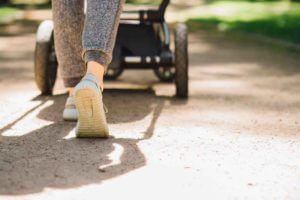The birth of a child is a very special experience for the new parents. After nine months of waiting, the baby finally comes into the world – and turns its parents’ lives upside down. Here you can find out what all changes with a baby and how it develops in the first few months.
Table of contents
The Birth – The Adventure Begins
After nine months of pregnancy, the time has finally come and your baby is about to be born. But it can take many hours before the baby is born.
When It Starts
An impending birth makes itself felt through pre-labor contractions, with which the body prepares for the event. They vary in strength and occur irregularly. Only then do the labor pains gradually set in. They are more painful than preterm labor and much more regular. The intervals between contractions become shorter over time, but the duration is longer. Labor pains cause the cervix to open so that there is room for the baby.
The contractions push the baby further and further into the pelvis. If the cervix is already wide open, the water will break. Once it is fully open, the baby can come into the world. In this phase of the birth, the expectant mother helps the baby on its way out by pushing along. With a few squeezing contractions, it is then also soon done, the child is born.
After The Birth

In the first hours after birth, many important things happen. Immediately after delivery, the midwife places the baby on his mother’s chest – the first encounter and the beginning of an intimate parent-child relationship. This is a very exciting moment for the parents.
Another event is the cutting of the umbilical cord. The baby is now finally separated from the womb. There is blood in the umbilical cord that will be tested. You can donate this blood, and there are some good reasons for doing so: The blood contains stem cells that can still transform into a wide variety of body cells. These cells are used to treat diseases such as blood, bone, or lymphatic cancer. The donation process is completely free of pain and risk but can save other people’s lives.
After birth, your baby will be thoroughly examined, first with the Apgar test, which is performed three times, and then with the examining gaze of the midwife. She looks very closely at the baby’s body and measures height and weight. The baby is then bathed and dressed. Then the mother is allowed to breastfeed her baby for the first time. With the “colostrum” she transfers antibodies to the child, the so-called nest protection. This protects the baby from diseases and bridges the period until the baby’s immune system begins to build up.
This Will Change
After your baby is born, many things will change. There are some challenges you will face as a new mom. They mainly concern your daily rhythm and your body.
Sleep Deprivation
Sleep deprivation is especially hard, and it becomes a faithful companion after birth. Once the baby is born, you will have little night’s rest for a long time. Your baby will have to get used to a sleep rhythm that will gradually settle in after a few weeks.
However, your baby will still be hungry and have full diapers at night. Sometimes babies cry for hours and cannot be calmed down. Especially at night, this saps your strength. Tummy aches, illness-related discomfort, and, later, the first teeth are the most common causes.
Free Time
As soon as the baby arrives, your daily routine will be based primarily on its rhythm and needs. This will also change the way you spend your free time.


Instead of hobbies of their own, walking with the baby in the stroller is now the top priority. Meetings with other mothers and their children, baby swimming, and toddler group become your new leisure activities.
When your baby is a little older, you can start to integrate your hobbies back into your daily routine. This also applies to your social contacts, which unfortunately have to take a back seat in the early days.
Your Own Body
One of the biggest challenges for moms after giving birth is their own bodies. It will feel and look strange at first: the belly that stretched during pregnancy is now flabby and wrinkled. The birth has also enlarged the vagina. It will feel strange at first because the pelvic floor muscles are still weakened.
The changes will last for a few months, after all your body first has to recover from pregnancy and birth. The incipient regression processes ensure that your body gradually regains its original shape. With the right tricks, you can relieve the pain that occurs during the process and support your body.
Stretch marks on the breasts and abdomen will fade over time with good skincare, and specific exercises will strengthen the pelvic floor muscles again. The breasts will only become smaller again after breastfeeding.
Baby’s Development In The First Months
After birth, your baby develops a little further every day. In the first few months in particular, he or she learns at breakneck speed and turns from a newborn infant into a bright, curious baby who wants to explore his or her environment.
The First Days With Child
[caption id="attachment_9638" align="aligncenter" width="380"]
When mother and child leave the hospital and are allowed to come home, some exciting days begin – the first days as a family. To ensure that the start of family life goes well, rest is very important. For one to two weeks, you should take time for your baby and block out the rest of the world for the time being.
During this time, you will get to know each other better and build a close relationship with your baby. You also need to learn how to breastfeed and find the right rhythm for bottle-feeding. Procedures such as diapering and baby care have to be adjusted, as well as the new sleeping rhythm and the daily routine, which is now constantly changing due to the baby.
In between, recovery from the stresses and strains of birth is the order of the day. But the U2 examination and the application for important documents are also on the agenda in the first week after the birth. These include the birth certificate and the application for maternity pay. In addition, the employer must be informed about the birth and the child must be registered with the health insurance company.
This Is What Your Baby Will Learn By The Third Month
During the first four weeks, eating and sleeping are your baby’s main activities. Movements, as well as sensory perceptions, are still very limited: hearing is not yet fully developed and visibility is only 30 centimeters. In addition, babies still see everything in a blurry way at the beginning.
But thanks to their early childhood reflexes (e.g. sucking and swallowing reflex, breathing reflex, and grasping reflex), babies are well equipped for life even in the first few weeks. In the course of development, these reflexes regress. They are replaced by movements and skills that your baby can perform with increasing independence and control from month to month.
As early as the second month, they begin to reach for objects more purposefully. They perceive their own movements more and more consciously and intensively, and their sensory perceptions gradually improve. In addition to the sense of touch, hearing and vision are also much better developed. With cooing and gurgling sounds, babies are now also doing their first speech exercises.
From the third month onwards, babies are really keen to move. While lying down, they kick their legs for all they’re worth. In this way, they strengthen their leg muscles – an important prerequisite for learning to crawl and walk later. Sitting is also practiced at this early stage. To do this, babies bend their legs when they lie on their backs.
In general, babies develop a keen interest in their caregivers and their environment in the first few months. They observe and feel everything they can to get to know the world better.
Images
Image 1: Fotolia.com © bevisphoto #103193253
Image 2: Fotolia.com © Alena Ozerova #197141952
Image 3: Fotolia.com © Iryna #159804388
Image 4: Fotolia.com © nataliaderiabina #172141517














46 thoughts on “When The Baby Is Finally Here – What Happens After Birth”